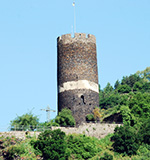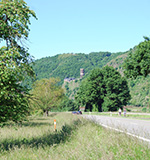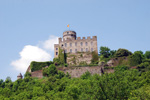History
Burg Bischofstein is perched on a steep slate spur above the west bank of the River Moselle in Germany. Known for its distinctive tower with a white plaster ring, it played a strategic role in controlling the Moselle crossings and the Baybach valley. It is currently used as a school retreat.

In 1259, the Archbishop of Trier, Arnold II von Isenburg, began construction of Burg Bischofstein. The castle construction was completed in 1273 by the Archdeacon of Trier, Heinrich von Bolanden, who then gifted the castle to the Archbishop of Trier.
The Archbishops of Trier used it as a retreat and often sought rest from their official business at the castle.
The castle escaped being damaged during the Thirty Years' War. However, in 1688, during the War of the Grand Alliance, Louis XIV of France sent in troops to weaken the Palatinate after it refused to ratify the Truce of Regensburg. In 1689, cannon fire from his troops destroyed some of the buildings of Burg Bischofstein. After repairs were carried out at the castle, troops of the French Revolutionary Army devastated the castle again.
On September 29th, 1803, the government of Napoleon Bonaparte auctioned off the castle and three hectares of land to the winemaker, Nicolaus Artz, with the proceeds going to the French treasury.
In 1933, the castle ruins were purchased by banker Erich Deku from Darmstadt, who began to rebuild the castle as a residential castle in a more modern manner. Burg Bischofstein was sold in 1954 to the Association for the Promotion of the School Camp Burg Bischofstein, and it now serves as a school camp.
In 1997, the tower was renovated, the battlements were reinforced, and the tower platform was rebuilt. A wooden staircase was added so visitors could access the top of the tower.
Castle Highlights
Burg Bischofstein is built on three terraces, with the 20-25 meter high tower rising from the top terrace. There was once a wooden parapet atop the tower, which was destroyed by fire in 1689.
On the south edge of the rock formation stands the castle chapel, which was rebuilt in the Gothic style after it was partially destroyed. The Pallas is located on the north end of the castle, and a ring wall surrounds the entire complex.
The castle is used as a retreat for school groups. Still, the tower is sometimes open on weekends to visitors and occasionally on special days, such as "Tag de offenen Burg" (Open Castle Day), where the castle is open to visitors and conducts guided tours.
Burg Eltz is close enough to visit the same day. You should start at Eltz and spend most of the day there, before visiting Burg Bischofstein. You may also want to call ahead to make sure Bischofstein is open to visitors on the day of your visit.




